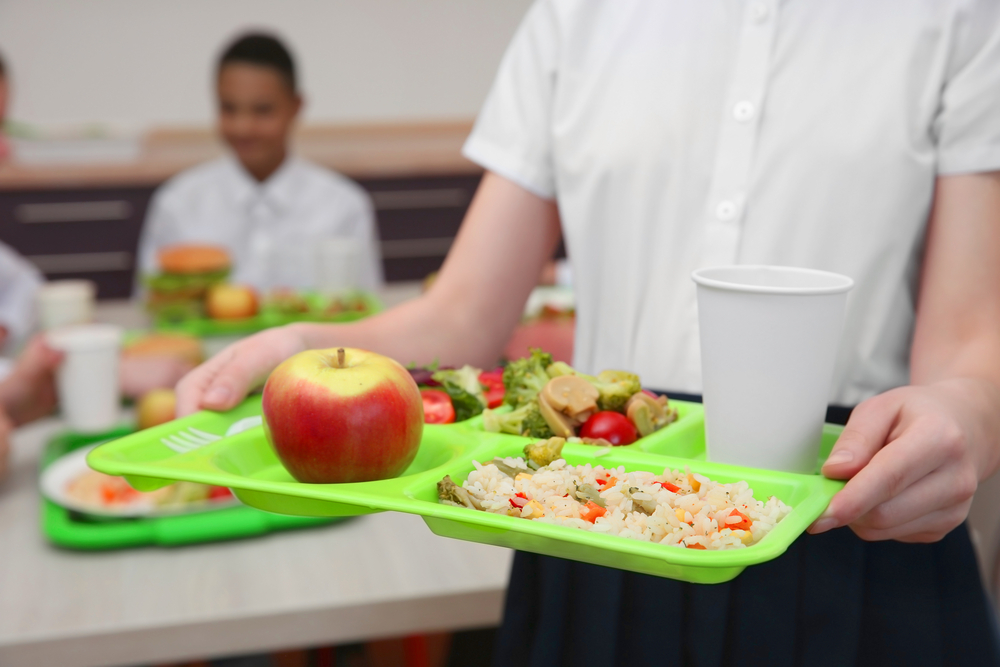Part of the Food Policy Snapshot Series
Policy name: Pandemic Flexibilities for School Meal Programs
Overview: All students will be able to continue receiving free, nutritious meals through 2022 whether or not their schools are open for in-person learning.
Location: United States K-12 schools
Population: Approximately 56 million K-12 students were enrolled in fall 2020.
Food policy category: Nutrition, food security
Program goals: To reduce hunger and provide nutritious meals for children.
How it works: Schools will serve meals through the National School Lunch Program Seamless Summer Option, which is usually only available during the summer months.
The meals will have a “strong emphasis on providing fruits and vegetables, fluid milk, whole grains, and sensible calorie levels,” and schools will receive increased reimbursement rates when they use this program.
The extension allows for the continuation of flexible meal service options that encourage social distancing, including meal pick-ups in non-group settings and pick-ups at irregular meal times.
The USDA will continue to offer technical assistance to schools as needed.
Progress to date: When the pandemic began and schools shut down in March 2020, many schools had to find innovative ways to continue providing meals to students in need, and the federal government issued numerous waivers to make that process easier. In June 2020, the Trump administration announced that students would be able to continue receiving free meals through the summer, regardless of where they lived. Then, In October 2020, the government provided another extension that provided free meals for all students through the end of the 2020-2021 school year. The most recent extension, which will run through 2022, was announced in April 2021.
Why it is important: Twelve million children in the United States currently live in households where they may not be guaranteed a healthy meal every day. These children often rely on the services provided by schools to make sure they receive the nutrition they need to maintain a healthy body and mind. Free school meals help to reduce rates of obesity, food insecurity, and poor health, while also improving children’s behavior, attention span, and academic ability.
The school closures and remote learning environments that have occurred as a result of the COVID-19 pandemic made it harder for students to receive the meals they were accustomed to getting while at school. At the same time, many parents also lost their jobs , making it harder for them to provide healthy meals for their children. Free school meals, regardless of location or income status, will benefit many families across the country.
Program/Policy initiated: The extension was announced on April 20, 2021.
Point of contact:
USDA Press
Email: Press@usda.gov
Similar practices: The USDA provided many similar waivers for other Food and Nutrition Services programs, including the Supplemental Nutrition Assistance Program (SNAP) and the Special Supplemental Nutrition Program for Women, Infants, and Children (WIC), to reduce hunger and food insecurity during the pandemic.
Evaluation: Evaluation has not yet been completed, as the program is still ongoing.
Learn more:
- Innovations in School Food During COVID-19 (Hunter College New York City Food Policy Center)
- Let Them Eat Lunch: The Impact of Universal Free Meals on Student Performance (Journal of Policy Analysis and Management)
- School Closures During COVID-19: Opportunities for Innovation in Meal Service (American Journal of Public Health)
- Universal School Meals and Associations with Student Participation, Attendance, Academic Performance, Diet Quality, Food Security, and Body Mass Index: A Systematic Review (Nutrients)
References:
- Benefits of School Lunch (Food Research and Action Center)
- Biden Administration Extends Universal Free School Lunch Through 2022 (The Hill)
- Biden’s USDA Says it Will Extend Free School Lunches for Kids through Spring 2022 (Business Insider)
- Child Nutrition COVID-19 Waivers (United States Department of Agriculture)
- Free school meals will continue through 2021-22 school year, USDA announces (KTLA 5)
- SNAP COVID-19 Waivers (United States Department of Agriculture)
- Trump Administration Extends Free Meals for Kids for Entire School Year (United States Department of Agriculture)
- USDA Ensures All Kids Can Get Free Meals This Summer as Nation Reopens (United States Department of Agriculture)
- USDA Extends Universal Free Lunch Through Next School Year, Bringing Relief to Millions of Food-Insecure Families (Washington Post)
- USDA Issues Pandemic Flexibilities for Schools and Day Care Facilities through June 2022 to Support Safe Reopening and Healthy, Nutritious Meals (United States Department of Agriculture)
- WIC COVID-19 Waivers (United States Department of Agriculture)


